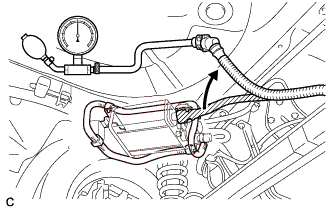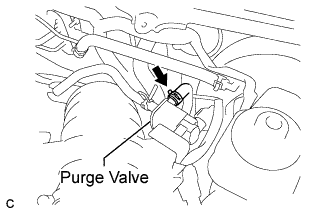Emission Control System -- On-Vehicle Inspection |
| 1. VISUALLY INSPECT HOSE, CONNECTIONS AND GASKETS |
Check that there are no cracks, leaks or damage.
- HINT:
- Detachment or other problems with the engine oil dipstick, oil filler cap, PCV hose or other components may cause the engine to run improperly.
- Disconnection, looseness or cracks in any part of the air induction system between the throttle body and cylinder head will allow air suction and cause an engine failure or engine malfunctions.
 |
| 2. INSPECT FUEL CUT RPM |
Start and warm up the engine.
Increase the engine speed to at last 3000 rpm.
Use a sound scope to check for injector operating sounds.
Check that when the accelerator pedal is released, injector operating sounds stop momentarily (at 2500 rpm) and then resume (at 1400 rpm).
If the result is not specified, check the injectors, wiring and ECM.Standard Item Specified Condition Fuel cut off rpm 2500 rpm Fuel injection restart rpm 1400 rpm
| 3. INSPECT LINE AND CONNECTORS |
Visually check for loose connections, sharp bends or damage.
| 4. INSPECT AIR TIGHTNESS IN FUEL TANK AND FILLER PIPE |
Disconnect the vent line hose from the canister.
 |
Connect the pressure gauge to the vent line hose.
Apply pressure to the fuel tank to create an internal pressure of 4 kPa (41 gf/cm2, 0.58 psi).
Check that the internal pressure of the fuel tank is maintained for 1 minute.
Check the connecting portions of each hose and pipe.
Check the installed parts on the fuel tank.
If any malfunctions, damage or other problems are found, replace the fuel tank and filler pipe.
Reconnect the vent line hose to the fuel tank.
| 5. INSPECT FUEL TANK ASSEMBLY |
Disconnect the vent line hose from the canister.
 |
Connect the pressure gauge to the fuel tank.
Fill the fuel tank with fuel.
Apply pressure of 4 kPa (41 gf/cm2, 0.58 psi) to the vent port of the fuel tank.
- HINT:
- Check the amount of fuel in the fuel tank. When the fuel tank is full, the float valve of the fill check valve is closed and no air can pass through.
Remove the fuel tank cap, and check that the pressure drops.
If the pressure does not drop, replace the fuel tank assembly.
Reconnect the vent line hose to the fuel tank.
| 6. INSPECT AIR INLET LINE |
Disconnect the air inlet line hose from the charcoal canister.
 |
Check that air can flow freely into the air inlet line.
If air cannot flow freely into the air inlet line, repair or replace it.
Reconnect the air inlet line hose to the charcoal canister.
| 7. INSPECT EVAPORATIVE EMISSION CONTROL SYSTEM |
Start the engine.
 |
Disconnect the vacuum hose from the purge valve as shown in the illustration.
Connect the Techstream to the DLC3.
Enter the following menus: Powertrain / Engine and ECT / Active Test / Activate the VSV for EVAP Control.
Check that a vacuum occurs at the purge valve port.
Exit Active Test mode and reconnect the vacuum hose.
If the result is not as specified, replace the purge valve, wire harness or ECM.